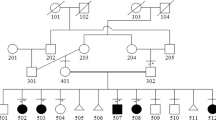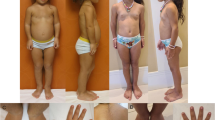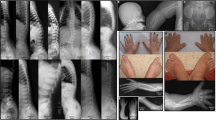Abstract
Leri-Weill Dyschondrosteosis (LWD; OMIM 127300) is a dominantly inherited skeletal dysplasia characterized by disproportionate short stature with predominantly mesomelic limb shortening1. Expression is variable and consistently more severe in females2, who frequently display the Madelung deformity of the forearm (shortening and bowing of the radius with dorsal subluxation of the distal ulna). The rare Langer Mesomelic Dysplasia3 (LD; OMIM 249700), characterized by severe short stature with hypoplasia/aplasia of the ulna and fibula, has been postulated to be the homozygous form of LWD (refs 4–6). In a six-generation pedigree with LWD, we established linkage to the marker DXYS6814 in the pseudoautosomal region (PAR1) of the X and Y chromosomes (Z max = 6.28; θ=0). Linkage analysis of three smaller pedigrees increased the lod score to 8.68 (θ=0). We identified submicro-scopic PAR1 deletions encompassing the recently described short stature homeobox-containing gene SHOX (refs 7,8) segregating with the LWD phenotype in 5 families. A point mutation leading to a premature stop in exon 4 of SHOX was identified in one LWD family.
This is a preview of subscription content, access via your institution
Access options
Subscribe to this journal
Receive 12 print issues and online access
$209.00 per year
only $17.42 per issue
Buy this article
- Purchase on Springer Link
- Instant access to full article PDF
Prices may be subject to local taxes which are calculated during checkout
Similar content being viewed by others
References
Léri, A. & Weill, J. Une affection congenitale et symetrique du developpement osseux: la dyschondrosteose. Bull. Mém. Soc. Med. Hop. Paris. 35, 1491–1494 (1929).
Lichtenstein, J.R., Sundaram, M. & Burdge, R. Sex-influenced expression of Madelung's deformity in a family with dyschondrosteosis. J. Med. Genet. 17, 41–43 (1980).
Langer,L.O. Mesomelic dwarfism of the hypoplastic ulna, fibula, mandible type. Radiology 89, 654–660 (1967).
Espiritu, C., Chen, H. & Woolley, P. Mesomelic dwarfism as the homozygous expression of dyschondrosteosis. Am. J. Dis. Child. 129, 375–377 (1975).
Fryns, J.P. & Van den Berghe, H. Langer type of mesomelic dysplasia as the possible homozygous expression of dyschondrosteosis. Hum. Genet. 46, 21–27 (1979).
Kunze, J. & Klemm, T. Mesomelic dysplasia, type Langer—a homozygous state for dyschondrosteosis. Eur. J. Paediatr. 134, 269–272 (1980).
Rao, E. et al. Pseudoautosomal deletions encompassing a novel homeobox gene cause growth failure in idiopathic short stature and Turner syndrome. Nature Genet. 16, 54–63 (1997).
Ellison, J.W. et al. PHOG, a candidate gene for involvement in the short stature of Turner syndrome. Hum. Mol. Genet 6, 1341–1347 (1997).
Khudr, G. et al. Y to X translocation in a woman with reproductive failure. J. Am. Med. Assoc. 226, 544–549 (1973).
Youlton, R., Castillo, S. & Be,C. Translocation of X;Y chromosomes in a woman with dyschondrosteosis and sterility. Rev. Med. Chile 113, 228–230 (1985).
Kuznetzova, T. et al. X;Y translocation in a girl with short stature and some features of Turner's syndrome: cytogenetic and molecular studies. J. Med. Genet. 31, 649–651 (1994).
Guichet, A., Briault, S., Le Merrer, M. & Moraine, C. Are t(X;Y) (p22;q11) translocations in females frequently associated with Madelung deformity? Clin. Dysmorphol. 6, 341–345 (1997).
Dib, C. et al. A comprehensive genetic map of the human genome based on 5,264 microsatellites. Nature 380, 152–154 (1996).
Ogata, T. et al. Chromosomal localisation of a Y specific growth gene(s). J. Med. Genet. 32, 572–575 (1995).
Ogata, T. & Matsuo, N. The Y specific growth gene(s): how does it promote stature? J.Med. Genet. 34, 323–325 (1997).
Ogata,T. & Matsuo,N. Turner syndrome and female sex chromosome aberrations: deduction of the principal factors involved in the development of clinical features. Hum. Genet. 95, 627–629 (1995).
Francisco, R.J.L. Buron, S.P., Martinez,P.E., Lozano,B.G. .& Blanc, R.F. Turner's syndrome. Relationship between the karyotypes and malformations and associated diseases in 23 patients. An. Esp. Pediatr. 47, 167–171 (1997).
Fisher, E. & Scambler, P.J. Human haploinsufficiency - one for sorrow, two for joy. Nature Genet. 7, 5–9 (1994).
Lathrop, G.M. & Lalouel, J.M. Easy calculations of lod scores and genetic risks on small computers. Am. J. Hum. Genet. 36, 460–465 (1984).
Author information
Authors and Affiliations
Rights and permissions
About this article
Cite this article
Shears, D., Vassal, H., Goodman, F. et al. Mutation and deletion of the pseudoautosomal gene SHOX cause Leri-Weill dyschondrosteosis. Nat Genet 19, 70–73 (1998). https://doi.org/10.1038/ng0198-70
Received:
Accepted:
Issue Date:
DOI: https://doi.org/10.1038/ng0198-70
This article is cited by
-
Rare dosage abnormalities flanking the SHOX gene
Egyptian Journal of Medical Human Genetics (2021)
-
SHOX haploinsufficiency presenting with isolated short long bones in the second and third trimester
European Journal of Human Genetics (2018)
-
Genes uniquely expressed in human growth plate chondrocytes uncover a distinct regulatory network
BMC Genomics (2017)
-
Identification of 15 novel partial SHOX deletions and 13 partial duplications, and a review of the literature reveals intron 3 to be a hotspot region
Journal of Human Genetics (2017)
-
Genome-wide copy number variation (CNV) detection in Nelore cattle reveals highly frequent variants in genome regions harboring QTLs affecting production traits
BMC Genomics (2016)



